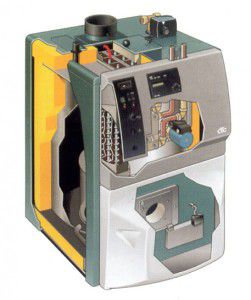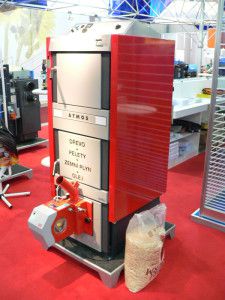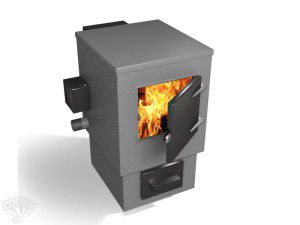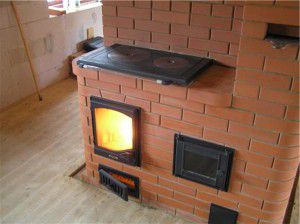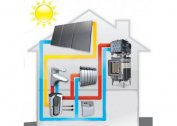During the planning of heating, they try to provide for all possible nuances and factors. An important of them is the type of low tide used. Therefore, in order to increase reliability and reduce the cost of maintenance, lately, combined boilers for heating a private house are increasingly being chosen.
The relevance of installing combined heating boilers
The main difference from standard models of heating equipment is the ability to use several types of energy source. Modern combined boilers for home heating can operate both on gas and on solid and liquid fuels. But models with built-in electric heating elements have become especially popular.
Heating a country house with a combined boiler may be relevant in several cases. First of all, the choice is determined by the possibility of using several types of fuel and their cost. In some periods of operation of the heat supply, it will be advantageous to use firewood instead of diesel fuel. The same applies to natural and liquefied gas, electricity.
Combined universal heating boilers are installed in the following cases:
- Reducing the inertia of the heat supply. The initial start-up of electric heating will allow you to quickly heat the water in the system. To maintain its temperature at the right level, you can use solid fuel or gas;
- Power Independence. Many foreign and Russian combined heating boilers have the ability to use a certain type of fuel without connecting to the mains - firewood, coal;
- Economical consumption. In the absence of the main energy carrier, combined gas heating boilers have the function of automatically switching to another type of fuel.
The main disadvantage that dual-circuit combined heating boilers have is their high cost. This is due to the complexity of the design and the actual duplication of many components to maintain a full set of functionality.
You can determine the optimal model for completing the heat supply of a house by reading reviews on combined heating boilers. However, one should remember their subjectivity.
Gas-electricity heating boilers
The most effective in terms of heating water in heating is electricity. The impact on the coolant occurs with a minimum delay, which entails a sharp increase in its temperature. Therefore, gas-electricity combined heating boilers are especially popular.
It is important to consider the small dimensions of such a design. The main advantage of gas-electricity combined heating boilers is their variability - installation of several circuits (heat supply and domestic hot water), the ability to connect to several heating systems.
The main advantages of combined gas-electricity boilers for heat supply are:
- Small dimensions. The gas combustion chamber is small, and the heater or other type of heating electric device can be installed directly in the heat exchanger;
- Low power consumption. Such combined boilers for heating a private house mainly run on gas. The electric heater is turned on in the absence of gas, or for operational heating of water;
- Affordable cost. Due to the lack of need to make a separate combustion chamber, since the heater is mounted in a heat exchanger.
In some models, when planning the heating of a country house with a combined boiler, it is possible to connect a boiler. This is relevant if the equipment does not have a secondary circuit for domestic hot water.
In most cases, the power of the heating elements is designed to maintain the desired temperature level in the heat supply system, and not for continuous operation. You should pay attention to this when choosing Russian combined heating boilers.
Combined heating wood-gas boilers
Currently, the most economical types of energy carriers are firewood and gas. That is why it is recommended to use combined wood-gas heating boilers to organize the heat supply of private houses.
Structurally, boilers of this type have two combustion chambers for each type of fuel. This leads to large dimensions of the heating equipment. Depending on the functional features, combined wood-gas heating boilers can have one or two heat exchangers. In the first case, they are common to each combustion chamber. In double-circuit combined heating boilers, the DHW function is performed using one of the types of fuel.
For all combined gas heating boilers before installation, it is necessary to correctly issue permits. At the same time, the Management Company in the Technical Conditions will focus on the technical properties of the gas component of the equipment. It is important that in the design of combined boilers for heating a house, the characteristics of the solid fuel part do not affect the gas.
There are two types of combined wood-gas heating boilers:
- With separate combustion chambers. Basically, these are factory models with two circuits. One of them heats water for heating, and the second provides hot water supply;
- With a common combustion chamber. This is more true for home-made installations, when it is necessary to minimize the costs of arranging heating of a country house with a combined boiler. A factory gas burner is installed in a standard boiler. In the case of firewood, it is dismantled.
Recent models have the most controversial reviews of combined heating boilers. Basically, these are home-made designs in which the heat exchanger is not designed for high thermal effects during the operation of a gas burner. This is what causes the boiler to fail frequently.
When choosing a gas burner for a solid fuel boiler, it is necessary to accurately measure the dimensions of the combustion chamber. They must correspond to the dimensions of the gas burner.
Combined heating boilers firewood-electricity
In the absence of the possibility of connecting to a gas main or organizing balloon heating, solid fuel boilers are most often used. They are non-volatile, have a sufficiently large capacity. However, for the unification of heat supply, it is recommended to use combined firewood-electricity heating boilers.
Structurally, they are largely similar to the gas models described above. The difference lies in the possibility of independent production of a combined boiler for heating firewood electricity. This work can be done without the involvement of socialists. It is enough to choose the heater with the required power and install it in the heat exchanger of a combined heating boiler.
There are ready-made factory models on the market with a full range of required equipment. Unlike home-made boilers, they have precisely calculated the location of the heating element, its power. The main indicator is the complete safety of operation. In addition to these indicators, it should be noted such features of combined boilers for heat supply, electricity, wood:
- Ability to connect additional devices. Often, manufacturers provide a contact part for connecting a heater block to a programmer or thermostat. You can consider options for remote control of the boiler;
- Work reliability. In factory models, combined boilers for heat supply to the house mount special heating elements that are not susceptible to breakdowns under large thermal effects from solid fuel furnaces;
- Maintainability. If the electrical part fails, it can be replaced by a similar one on its own. Alas, combined gas boilers for heat supply in most cases do not have such a function.
To select a combined boiler for heating a private house, firewood-electricity, you must first calculate the power of the heater. Experts advise models in which this figure is at least 70% of the required for heating a private house.
Solid fuel boiler power adjustment is extremely slow. Therefore, if it is necessary to quickly change the degree of heating of the coolant, it is recommended to activate the electrical part of the equipment.
The device of combined furnaces for heating
Using brick stoves is a traditional way of heating a small house. But in this case, you can improve the standard design by making a number of changes. Currently, there are modern combined furnaces for heating a house, ensuring the stability of the system and a high rate of efficiency.
The advantage of the brick construction is not only the ability to use several types of fuel (firewood, gas, diesel), but also a possible modification of the device.
In contrast to the heat supply of a country house, a combined boiler in the furnace can make several heat exchangers, equip the coarse, install an indirect or direct heating boiler. However, each such innovation will directly affect the dimensions of the structure.
Recently, the following modifications of combined furnaces for heating a house have been made:
- Hob installation. This is a classic way to enhance functionality. In addition to the heat supply on the stove, you can cook food;
- Burner mounting. To do this, you can use a gas or solid fuel burner. But it is best to use gas models, since with normal traction they do not create an unpleasant odor in the room;
- Water heat exchanger. By installing a tubular structure in the furnace, you can make a small but effective heating system at home. It is necessary to take into account its great inertia - heating of water in combined furnaces for heat supply at home and heating of water in pipes will occur slowly.
Even less common can be found dual-circuit combined heating boilers in furnaces. This is due to the small size of the heat exchanger. To ensure hot water supply, it is best to install a tank for direct or indirect heating of water.
Regardless of the design of the furnace, before its construction, a separate foundation must be made that is not associated with a common house. This measure is necessary due to the large mass of the structure, as well as the chimney system.
Universal combined heating boilers
In some cases, it is advisable to use universal heating boilers, which provide for the use of not only two types of fuel.These include heating boilers combined gas-firewood-electricity, pellet models.
The defining difference that pellet combined heating boilers have is the presence of several combustion chambers. They are adapted for the use of a certain type of fuel - gas, diesel, firewood, etc. As an additional measure, an electric heater can be provided located in one or more chambers of the heat exchanger.
It is noteworthy that in many models of combined heating boilers gas firewood electricity, the pellet burner is removable. Those. a combustion chamber for it can be used for another type of fuel. Most often it is gas or diesel. The conditions for the use of these energy sources include the presence of forced air injection and the complex design of the heat exchanger for the transfer of thermal energy. These qualities are also characteristic of pellet combined heating boilers.
For the operation of multi-fuel heating boilers, the following conditions must be met:
- Stable power supply. It is needed for the operation of combined pellet heating boilers, gas and diesel burners. Exceptions are the use of solid fuels;
- Organization of fuel delivery to the boiler. The main problem in planning the installation of combined heat, gas, firewood, electricity boilers is the storage of energy. For balloon heating, separate rooms are made or external steel boxes are installed. Diesel fuel is stored in barrels that are connected to a special pumping station.
Before you purchase universal boilers for heat supply combined, you should analyze the feasibility of their use. Their cost is an order of magnitude higher than classic single-fuel ones. To do this, make a detailed financial analysis for each type of energy carrier.
When installing foreign and Russian combined heating boilers, you need to correctly calculate the diameter of the chimney. The draft rating should meet the minimum requirements for each type of fuel.
Responses of owners of combined heating boilers
An additional way to determine the relevance of using one or another combined heating boiler is a detailed study of the reviews. They will help you to anticipate possible problems during installation and operation. It should be noted that not all reviews of combined boilers for heat supply are positive:
- 15 years ago during the construction of the house provided for the installation of two boilers - gas and solid fuel. Over time, I began to notice that the service of everyone is becoming more expensive. I decided to try a combined gas-wood boiler. The result was more than good. The heating operation was almost completely automated, the failures stopped;
- For a long time I looked narrowly at the boiler gas-electricity. The only obstacle to the purchase was its high cost. Finally decided and acquired. In practice, the boiler efficiency was lower than in the passport. There may be a gap in the heating circuit. I plan to call specialists to analyze the situation;
- In two years, they plan to bring main gas to our village. I decided to prepare for this event in advance and purchased a gas and coal boiler. After the first heating season, impressions are only positive. It remains to wait for the gas connection and check the operation of the equipment on it.
Regardless of the type of combined boiler, before purchasing it, you need to carefully consider the entire heating system. This applies to the piping system, chimneys and heating safety device. In combination, they must ensure normal heating of the house at optimal energy costs.
In the video material you can see an example of the operation of a pellet combined boiler for heating a house:

